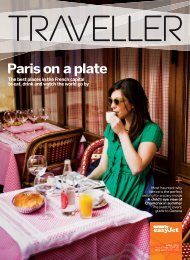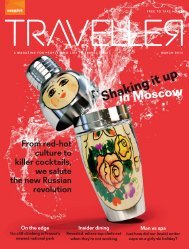november-2010
november-2010
november-2010
Create successful ePaper yourself
Turn your PDF publications into a flip-book with our unique Google optimized e-Paper software.
SHORTS | PAPRIKA<br />
TASTE<br />
BUDS<br />
Red Gold<br />
Feeling Hungary? Get<br />
an authentic taste of<br />
Budapest with the subtle<br />
sweetness of paprika<br />
PAPRIKA BOUGHT<br />
from a supermarket<br />
often smells good,<br />
but doesn’t really<br />
make a difference<br />
to the fl avour of<br />
your food. You may<br />
fi nd it surprising<br />
that Hungarians<br />
hold the orangey<br />
powder in such high<br />
esteem, but try the<br />
genuine article and<br />
you’ll understand.<br />
Real Hungarian<br />
high-grade paprika,<br />
available in a palette<br />
of fi ery colours<br />
from letterbox red<br />
to a brilliant auburn<br />
(its nickname is<br />
red gold) adds<br />
depth of fl avour,<br />
rich colour and an<br />
LIQUID INDULGENCE APEROL<br />
VENICE<br />
No-one does light<br />
and refreshing<br />
apéritifs quite like<br />
they do in Venice,<br />
home of the<br />
extremely quaffable<br />
spritz (a wine-based<br />
cocktail). So, if<br />
you’re lucky enough<br />
to fi nd yourself in<br />
the city of canals<br />
looking out from a<br />
bacari (wine bar)<br />
across a buzzing<br />
unmistakably spicy<br />
sweetness to any<br />
dish it’s added to.<br />
Paprika is created<br />
from the dried,<br />
ground powder of<br />
the capsicum (red<br />
chilli pepper) that<br />
was fi rst introduced<br />
to Western Europe<br />
by Christopher<br />
Columbus in the late<br />
15th century. Use<br />
of chillis gradually<br />
spread across<br />
Europe, and arrived<br />
in Hungary during<br />
the rule of the<br />
Turkish Empire in<br />
the 16th century.<br />
What happened<br />
next is the stuff<br />
of legend. Some<br />
claim the pretty<br />
piazza, order a spritz<br />
al Aperol. Made<br />
with Aperol, a fruity<br />
Italian concoction<br />
in a somewhat<br />
alarming orange<br />
hue, this spritz is<br />
subtly fl avoured by<br />
the orange, rhubarb<br />
and gentian in the<br />
alcoholic spirit.<br />
Aperol was<br />
launched in 1919<br />
by the Barbieri<br />
brothers from<br />
98 | TRAVELLER | 15 TH BIRTHDAY ISSUE<br />
red peppers, or<br />
pimentos, were<br />
fi rst grown by the<br />
wealthy purely<br />
for ornamental<br />
purposes, and that<br />
it was the peasants<br />
who started using<br />
Venice and quickly<br />
became one of<br />
Italy’s favourite<br />
drinks. Its name<br />
comes from apéro,<br />
the French word for<br />
an aperitif, and at<br />
just 11% alcohol (or<br />
poco alcolico – “a bit<br />
alcoholic” according<br />
to the label), it’s a<br />
gentle way to start<br />
a long evening of<br />
socialising and<br />
eating among<br />
them to liven up<br />
food. In other<br />
tales, the valuable<br />
peppers were<br />
jealously guarded<br />
by the aristocracy,<br />
who introduced<br />
the death penalty<br />
friends and family<br />
– just the way the<br />
Italians like it.<br />
To make the<br />
perfect Aperol<br />
spritz, place a few<br />
ice cubes in a glass,<br />
gently pour in three<br />
parts prosecco, a<br />
dash of soda and<br />
then two parts<br />
Aperol – added last<br />
so it doesn’t settle<br />
on the bottom.<br />
aperol.com<br />
for any peasant<br />
found growing<br />
them. Whatever<br />
the case, by the<br />
1600s the spice was<br />
becoming a staple<br />
of Hungarian cuisine<br />
in homemade<br />
sausages and<br />
salamis, fi sh soups<br />
and, of course,<br />
goulash – the meat<br />
and vegetable stew<br />
widely regarded<br />
as the country’s<br />
national dish.















